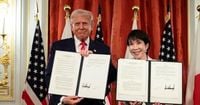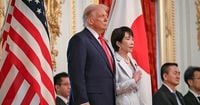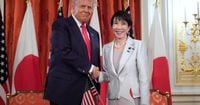In a week marked by historic firsts and high-stakes diplomacy, Japan’s new prime minister, Sanae Takaichi, took center stage as she welcomed U.S. President Donald Trump to Tokyo for their inaugural summit. The meeting, held on October 28, 2025, at the stately Akasaka Palace, signaled a pivotal moment in the Japan-U.S. alliance and set the tone for a rapidly shifting geopolitical landscape in Asia.
Takaichi, 64, is no stranger to breaking barriers. After two failed attempts, she secured her long-coveted role as Japan’s first female prime minister in a parliamentary vote just a week prior. A self-proclaimed admirer of Margaret Thatcher, Takaichi is known for her conservative stance within the ruling Liberal Democratic Party (LDP), her tough rhetoric on immigration, and her nuanced views on women’s equality. As a former government minister, television host, and even a heavy metal drummer, she brings a unique flair to Japanese politics, now tasked with steering the nation through economic stagnation, demographic decline, and mounting security challenges.
Her first major international test came swiftly. President Trump’s arrival in Tokyo was part of a broader Asia tour aimed at reshaping trade relationships, strengthening alliances, and addressing simmering tensions with China and North Korea. The summit between Trump and Takaichi was more than a diplomatic formality—it was a chance to reset the tone of U.S.-Japan relations and chart a new course for regional stability.
During their meeting, Takaichi heralded what she hoped would be “a new golden age of the Japan-U.S. alliance,” according to CNN. Trump, never one to shy from grand pronouncements, responded in kind: “You will be one of the great prime ministers,” he told Takaichi, as reported by CNN, adding, “This will be a relationship that will be stronger than any before and I look forward to working with you and on behalf of our country.”
At the heart of their talks was a comprehensive trade agreement, formally signed that day. The deal, months in the making, opens Japan’s market to American rice, automobiles, and defense equipment, while reducing tariffs on Japanese goods entering the U.S. to 15%—a marked decrease from the 25% initially threatened by Trump. In exchange, Japan pledged to invest a staggering $550 billion in U.S. industry. “We’re going to do tremendous trade together, I think more than ever before,” Trump declared, calling Japan “an ally at the strongest level,” as cited by CBS News.
But the economic pact wasn’t the only headline. In a strategic move to counter China’s near-monopoly on critical minerals and rare earth elements—materials vital for everything from smartphones to fighter jets—the leaders inked a framework for bilateral cooperation on securing and processing these resources. “The two leaders agreed to support the supply of raw and processed critical minerals and rare earths crucial to the domestic industries of the United States and Japan,” CNN reported, highlighting the urgency of diversifying supply chains amid ongoing trade tensions with Beijing.
The symbolism of the moment was not lost on either side. Takaichi, a protégé of the late Shinzo Abe, presented Trump with a putter once owned by the assassinated former prime minister and a golf bag signed by Japanese golf sensation Hideki Matsuyama. The gesture was more than a nod to shared sporting interests; it underscored the continuity of Japan’s commitment to its U.S. partnership. Both leaders signed black baseball caps emblazoned with “Japan Is Back” in gold, a playful riff on Trump’s own “America Is Back” slogan.
Personal diplomacy aside, the summit was also shaped by somber reminders of unfinished business. Trump and Takaichi met with families of Japanese citizens abducted by North Korean agents in the late 1970s and 1980s—a longstanding source of anguish in Japan. The families, clutching photos of their missing loved ones, appealed for renewed efforts to resolve the cases. Trump, who had met with some of the families during his first term, assured them, “I’ve met the families before and I’m with them all the way,” according to CNN. Japanese officials hope Takaichi’s advocacy, combined with Trump’s influence, might finally spur progress, though no meeting with North Korean leader Kim Jong Un was scheduled.
The day’s events were tinged with historical resonance in other ways. Just hours after the summit, the trial began for the alleged assassin of Shinzo Abe, whose death in 2022 shocked the nation and the world. Takaichi, widely seen as Abe’s political heir, paid tribute to his legacy throughout her remarks, reaffirming her intent to carry forward his vision of a robust U.S.-Japan alliance.
Amid the ceremonial and strategic milestones, Takaichi made a notable gesture by nominating Trump for the 2025 Nobel Peace Prize, a move reported by the White House and widely interpreted as a diplomatic olive branch. While the Norwegian Nobel Committee ultimately awarded the prize to Venezuelan opposition leader María Corina Machado, Takaichi’s nomination was the latest in a series of international endorsements for Trump—often timed around key negotiations.
The summit’s outcomes reverberated beyond Tokyo. Trump’s Asia tour, which began in Malaysia and was set to continue to South Korea and a meeting with Chinese President Xi Jinping at the APEC forum, was framed by escalating trade disputes. The U.S. president announced additional tariffs on Chinese imports, raising the total rate to 140% effective November 1, 2025, in retaliation for Beijing’s export controls on rare earths. The ripple effects were felt in global markets and in diplomatic capitals from Seoul to Washington.
For Takaichi, the whirlwind week was a baptism by fire—balancing domestic challenges, from economic malaise to a declining birthrate, with the demands of high-wire international diplomacy. Her conservative credentials and close ties to Abe have earned her respect among Japan’s right, but she faces skepticism from opposition parties and a public wary after years of political scandal. As BBC noted, Takaichi’s leadership will be tested not only by her ability to manage relations with Washington, but also by her approach to immigration, social policy, and the far right’s growing influence within the LDP.
Yet, as the applause faded in the Diet and the last handshakes were exchanged at Akasaka Palace, one thing was clear: Japan, under its new prime minister, is determined to assert itself on the world stage, even as it navigates the complexities of alliance politics in an era of uncertainty. The coming months will reveal whether Takaichi’s vision of a “new golden age” for the U.S.-Japan relationship can withstand the pressures of geopolitics, economics, and history.


